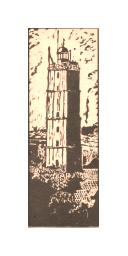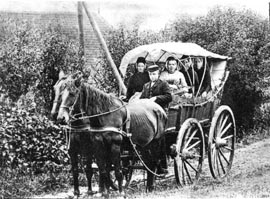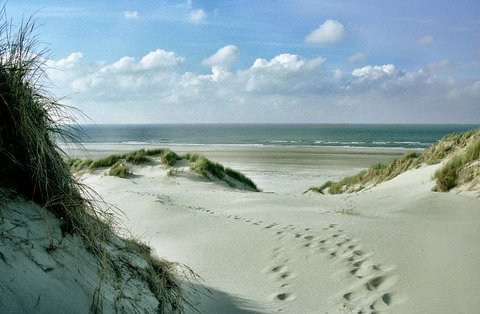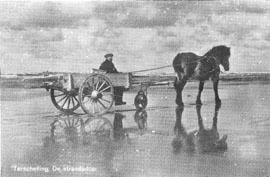
Hinne de Jong
A Chronicle
translated/arranged by his son, Sense de Jong
The pre - WW I years
- 1: Introduction
- 2: Captain Pieter
- 3: Childhood years
- 4: Shipwreck
- 5: Teenager
- 6: Spring remembered
- 7: That's how it was
- 8: Pre World War I
- 9: Mobilization (1914-1918)
- 10: Boys will be boys
- 11: Hinne leaves Terschelling
- 12: Hinne meets his true love
- 13: An eventful move
- 14: A serious illness
- 15: The war years (1940-1945)
- A1: Memories of Pa (by Truus)
- A2: Memories of Moe (by Truus)
- A3: Pa talks again
- A4: Cornelis Jacob de Jong
Another site by Sense de Jong:
~ Sense de Jong ~
Reminiscences
Sites by Henry de Jong:
~ Herman de Jong ~
Memorial
~ Newmaker Notes~
Writings, Pictures, Collections
~ AACS/ICS Niagara Conferences~
1970 - 1991
It's still in the early 1900s. One evening, Hinne and his younger brother, Tjebbe, were walking back to West-Terschelling along the cross-dike, passing the little lighthouse that was there. They came upon the horse of "Ome" - that's what they always called this man. They knew this mare was pregnant. Coming closer they noticed she was constantly walking around, tied up to a stake in the ground. When she started to go down, Hinne told Tjebbe to get Hermanus (or Manus), one of their cousins. Tjebbe ran away. But now the foal was coming. Hinne saw the legs and knew he had to cut the membrane. He had seen this with a cow, but never with a horse. Hinne pulled on the legs with all his might and soon the foal was free from the womb. Meanwhile, Manus had arrived and proceeded to cut the umbilical cord. He also tied up the membrane before the mare got back on her legs. He explained that if the wind gets into that membrane, it acts like a soccer ball and might scare the wits out of the mare.
Manus went home, leaving the boys alone with the animals. What to do? Find "Ome." But that was easier said than done because the old man lived some distance away. Already the foal stood shakily on his legs, but he could walk. Finally, "Ome" arrived and he and the boys with the animals walked all the way to the village where "Ome" lived. There the animals were bedded down in the barn. Hinne wrote that he does not remember ever getting a thank-you for all his work. He and Tjebbe spent most of the night helping out. But they had learned a lot....
"Opperied" on Terschelling
The Terschellingers say "op 'e riid," which is often written as "opperied." Translated, it means, "on a ride" or “going for a drive." It is usually associated with a festive or special day when the farmers would use their covered wagons or coaches to give the civilian population a ride to various interesting spots on the island.
Hinne wrote how well he remembered the procession of five to six horse-drawn wagons leaving West-Terschelling. Each wagon carried about three couples, often dressed in native costumes, with the farmer up front holding the reins. One could hear the songs they were singing from far away. There they came, along the "Dellewal," then left towards the main road. Here they usually stopped, at a "dobe," a place where the horses could drink. This was also a sign for the "opperied" passengers to cry out "lens ut de wein” - an excuse to sip a little wine.
They would journey to Formerum, where they would turn at the mill towards Midsland. Off and on, you'd hear the call "lens ut de wein" and more wine flowed. The destination was a Midsland hotel. There the couples would go for a leisurely stroll in the dunes and in the evening the dancing began.
Around ten o'clock they started the return trip. Coming to the "Dellewal" the farmers would race each other, going pell-mell for the village. Then everyone, arm in arm, would go through the streets of West-Terschelling, singing all the time. Sometimes the farmers had had a few drinks too many and would just let their horses walk back to their homesteads. They'd ask Hinne to go with them. He enjoyed bringing those horses back at night.
It also happened that Hinne and his siblings went "opperied" with their parents. They would then visit Volkert Spanjer - a good friend of the de Jong family - in Hoorn, a beautiful village lying east of Midsland. There they were treated to large slices of white bread, covered with butter and white sugar - a real delicacy then.
"Sint Jan"
Another time they went to Jan Roos in Midsland, the skipper of the Amsterdam-Terschelling cargo-boat, where the family enjoyed a warm meal. This happened usually on the day called "Sint Jan," or "Saint John", the 24th of June. It was a day for horse races, and the "lazy" Amelander, the de Jong family workhorse, participated.
One day, Hinne's cousin, Hermanus de Jong, asked Hinne's Dad: "Ome Kees, would you let me race with the Amelander?" He got a reluctant yes! So, Manus took the Amelander and tried him out on a lonely stretch of road. When a Midslander farmer saw that, he said: "Nou mut et net rarer wurre" or "Does it get any crazier than that?" He meant:" If the Amelander participates, than I'll get one of my cows to race him!"
The first race was at two o'clock. The Amelander won, and he won the second race, too. And for several years thereafter the Amelander won all first prizes. Those prizes consisted of rather expensive objects, which, for many years, were on display in the de Jong "mooie kamer" (front living room).
On tour with the coach (Dutch=koets)
When the road between West and East had been improved they went "opperied" with the coach. And, sometimes, Hinne himself was the driver.
One day, they made a trip and Hinne unharnessed the horses at a hotel in Midsland. There they met Jantje, a sister of Jan Roos, the skipper. The dancing started in the evening. Hinne wrote: "I had never done that, but the daughter of Pieter Kooyman persuaded me, and I tried it. We went around and around, but then I got so dizzy I fell lengthwise on the floor and the whole hall turned around with me. Oh, did they ever laugh then. But I was happy to sit on a chair again!"
When Reverend Vosschers (pastor of the "Hervormde Kerk" in West-Terschelling) had a preaching assignment in Hoorn, we often took him there in the coach, wrote Hinne. "We would leave the horse at Volkert Spanjer and , in nice weather, we'd just let him graze outside." Hinne continued: "For many years we drove a Mr. de Bruin, a representative of a business in Harlingen. He always wanted to go to Lies where the Bakker family ran a dry-goods store. During one of these trips, our dog ran all the way with us to Lies. Arriving there, Mr. de Bruin said: 'Hinne, did you know that your dog stopped for a ‘plasje’ (pee) at every tree and pole?'"

When the members of the choir made a trip, several coaches were used. Also, in those days, agricultural classes were held in Midsland. Hinne went there with Willem van Leunen and Jan Roos. They then took turns driving the coach, taking along the teacher, a Mr. Wiegersma, who lived in West-Terschelling and taught at the Nautical School. Hinne recalled a trip they made to Midsland on "Sinterklaas" (St. Nicholas) eve. In the darkness, the "Sunderums" (ghost-like, masked villagers) appeared with long chains trying to corner them on Midsland's main street. Hinne and the guys hit back and escaped.
The cranberry season
The American cranberry or peatberry (Hinne mentions the Latin=vaccinium macrocarpum) grew in the valleys between the dunes of Terschelling. When Hinne was a teenager, a Mr. Mulder leased those valleys to harvest the berries.
Hinne and his brothers, Herman and Tjebbe, all picked cranberries. Someone stood on the "Helmeduin," a high dune, and gave a signal with a flag indicating the picking could start. Everyone then worked hard to fill as many containers as possible. The more you picked the more you got paid. However, because of the large number of pickers it would be all over in a few days.
Hinne wondered why it is that those cranberries flourish only on Terschelling and nowhere else in the Netherlands. Experts believe it is because of the unique soil/vegetation/water conditions that exist on the island. Legend has it that a beachcomber found a barrel in the sea and hid it in the dunes. It seemed to have been forgotten. In time, that barrel broke open and out came the berries. The birds took care of the rest. The berries got spread out into the valleys where one would likely find peat-like soil and lots of water. Today, one can pick cranberries all over the island.
Tree planting on Terschelling
The year 1920 marked the start of a tree planting project in various areas on Terschelling. Today, when you walk or bike through the woods on the island, you can tell that the trees are not that old and that they were planted, because of the straight lines.
Before the planting of the fir-trees, the soil had to be prepared. Strips one meter wide and ninety cm. deep were dug. These strips were one meter apart, so the distance between the trees was appr. two meters. Hinne and his friends often worked in the dunes to help in this forestation project. The Dutch Government Department of Forests ("Staatsbosbeheer") had leased some land close to Midsland for the purpose of cultivating the plants. Hinne went there as well, working for a foreman, named Jan Schol, who later became a forester with "Staatsbosbeheer."
Altogether some 340 hectares of forests were planted on the west-side of the island, and 207 hectares on the east-side (whenever Hinne wrote down figures and measurements, you could count on them being correct -sdj).
Timber on the beach!
The North Sea beach was and is an area full of adventure and excitement - a place the de Jong boys loved to visit. As mentioned earlier, the three-master the "Fernando," ran aground during the year 1908. It was loaded with wooden planks which all went overboard and drifted ashore near "Paal 2." Hinne remembered going there after school. They hastily wrote the family name on the planks with red chalk and dragged them into the dunes. Then they tried to persuade Opa Cornelis, Hinne's Dad, to pick them up. But he had other ideas. What happened was that the farmers on the island were faithfully delivering the timber to the Receiver of Wrecks ("Strandvonderij"), hoping to earn some money that way. But because of the very large quantity of wood, the earnings were low. Anyhow, many slaved away on this project for more than a month. The horses were losing a lot of weight. In one month they ate as many sacks of oats than would usually be enough for a whole winter. The de Jong family, too, ended up buying more feed for the horses.

The North Sea beach near "Paal 8."
A close call
A year later, a whole load of heavy beams drifted ashore near "Paal 18," close to Oosterend, the easternmost village on Terschelling. Many farmers trekked out there and Hinne was allowed to go with his brother Herman. To their great disappointment, they found only two beams. They drew lots, and Kees Ruig and Douwe Roos each got a beam. Hinne and Herman went back empty. Herman was happy because now he could spend some time with his girlfriend!
As they raced along the sea, from "Paal 18" to "Paal 6," where they would turn to go into the dunes to go home, Herman suddenly saw something in the sea near "Paal 10." Full speed, he stormed straight into the sea. Hinne sat on the back of the three-wheeler and quickly noticed that the horses began to swim. Coming close to the beam, Herman hollered to Hinne: "Grab that beam!" But the waves made it impossible. Hinne fell off the wagon and disappeared below the water. Hinne wrote: "Fortunately, I was able to grab the rear wheel and in no time I climbed up to the top." He said to Herman: "I nearly drowned because of that rotten piece of wood!" Herman was happy that Hinne was on the wagon again and got out of there fast. He made it in time to be with his girlfriend, Trijntje, whom he later also married.

Beachcombing at night
Hinne wrote about a real beachcombing character, a real Skylger, with the name of Jannie Wever. If Jannie had found just a few planks of wood, then Herman knew enough: there must have been more. Jannie would wake up Herman, who got his Dad out of bed, who then went to Hinne, saying:" You need to get up. Wood on the beach!" Oh, how hard it was for Hinne to get up, but he always liked the adventure.
Herman drove the horses through the dunes to "Paal 6." Hinne often wondered how the horses found their way at night. Herman couldn't see a thing and he'd just let the horses go. Sometimes it was so dark on the beach that they would drive over the planks before seeing them.
Wrote Hinne: "Anyhow, we didn't want other farmers in West-Terschelling to know what we knew. To get ready for such an adventure, we'd prepare the wagon on the threshing floor, with the horses' harnesses all laid out. When Jannie Wever warned us, we'd quietly get the horses from their stalls and in front of the wagon. Then the giant doors would be opened, and away we went, as quietly as possible. The horses were not allowed to neigh, but how do you tell a horse that? Three to four other farmers lived very close to us and were not allowed to hear us. Often we made it. Away from the village, the horses would go full trot to the dunes."
One day, many, many planks were found near "Paal 8." They brought load after load to a place behind a dune and then a man would remain behind to guard the pile. They kept finding more wood until they came to "Paal 2," six kilometers down the beach. There was no more wood to be seen.
When you are at "Paal 2," you can see across the "Noordvaarder" or the “Groene Strand” (an area of beach where grass grew), and what they then saw they would not forget. There they came - the other farmers from West-Terschelling - hoping to cash in on the find. But they were too late, the loot was gone, or better, hidden. Hinne felt kind of sorry for them.
But what a beautiful sight in the morning mist: all those horses and wagons on that immense stretch of sand....
[an error occurred while processing this directive]